
21-Year-Old Female with Skeletal Injuries
While riding her bike to campus, 21-year-old Liliana Rose was struck by a car. Examination in the Emergency Department reveals several injuries. Relative to her integumentary system, the following comments are noted on her chart:

•Epidermal abrasions of the right lateral upper arm and anterior shoulder.
•A deep, 2-cm laceration extending vertically on right lateral cheek and a horizontal 1-cm laceration on the temple.
•Cyanosis is apparent in her nail beds and lips.
The lacerated areas are cleaned, sutured (stitched), and bandaged by the emergency room (ER) personnel.
5. Two nursing students are discussing wound care, especially for abrasions. “The biggest issue is all the stuff the skin secretes!” one of them complains. “It’s crazy hard to keep a wound clean, and the patient is losing fluid through the abrasions. Plus all that acid! The last thing a wound needs is acid on it! Why hasn’t anyone developed a dressing that can stop skin secretions?”
The other student disagrees. “I don’t think skin would heal as well without its secretions. Doesn’t the body usually know what it’s doing?”
What’s your opinion, and why?
Learn your wayIncludes step-by-step video

Chapter 5 Solutions
HUMAN ANATOMY+PHYSIOLOGY-ACCESS(IAC)
Additional Science Textbook Solutions
Cosmic Perspective Fundamentals
Campbell Essential Biology (7th Edition)
Introductory Chemistry (6th Edition)
Microbiology with Diseases by Body System (5th Edition)
Human Biology: Concepts and Current Issues (8th Edition)
Campbell Essential Biology with Physiology (5th Edition)
- Other than oil and alcohol, are there other liquids you could compare to water (that are liquid at room temperature)? How is water unique compared to these other liquids? What follow-up experiment would you like to do, and how would you relate it to your life?arrow_forwardSelection of Traits What adaptations do scavengers have for locating and feeding on prey? What adaptations do predators have for capturing and consuming prey?arrow_forwardCompetition Between Species What natural processes limit populations from growing too large? What are some resources organisms can compete over in their natural habitat?arrow_forward
- Species Interactions Explain how predators, prey and scavengers interact. Explain whether predators and scavengers are necessary or beneficial for an ecosystem.arrow_forwardmagine that you are conducting research on fruit type and seed dispersal. You submitted a paper to a peer-reviewed journal that addresses the factors that impact fruit type and seed dispersal mechanisms in plants of Central America. The editor of the journal communicates that your paper may be published if you make ‘minor revisions’ to the document. Describe two characteristics that you would expect in seeds that are dispersed by the wind. Contrast this with what you would expect for seeds that are gathered, buried or eaten by animals, and explain why they are different. (Editor’s note: Providing this information in your discussion will help readers to consider the significance of the research).arrow_forwardWhat is the difference between Uniporters, Symporters and Antiporters? Which of these are examples of active transport?arrow_forward
- What are Amyloid Fibrils? What biological functions are these known to perform?arrow_forwardHow do histamine and prostaglandins help in the mobilization of leukocytes to an injury site? What are chemotactic factors? How do they affect inflammation process?arrow_forwardCompare and contrast neutrophils and macrophages. Describe two ways they are different and two ways they are similar.arrow_forward
 Medical Terminology for Health Professions, Spira...Health & NutritionISBN:9781305634350Author:Ann Ehrlich, Carol L. Schroeder, Laura Ehrlich, Katrina A. SchroederPublisher:Cengage Learning
Medical Terminology for Health Professions, Spira...Health & NutritionISBN:9781305634350Author:Ann Ehrlich, Carol L. Schroeder, Laura Ehrlich, Katrina A. SchroederPublisher:Cengage Learning- Understanding Health Insurance: A Guide to Billin...Health & NutritionISBN:9781337679480Author:GREENPublisher:CengageEssentials of Pharmacology for Health ProfessionsNursingISBN:9781305441620Author:WOODROWPublisher:Cengage





